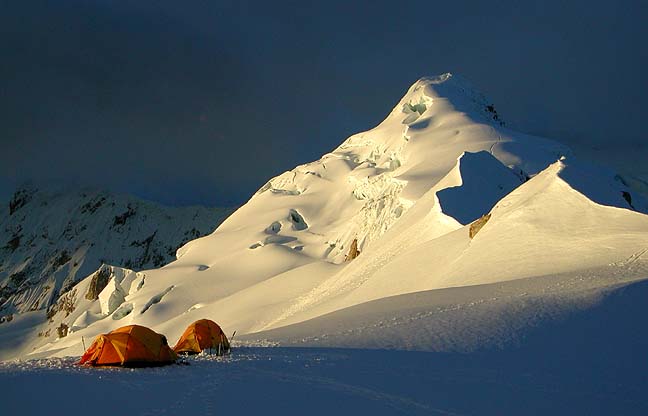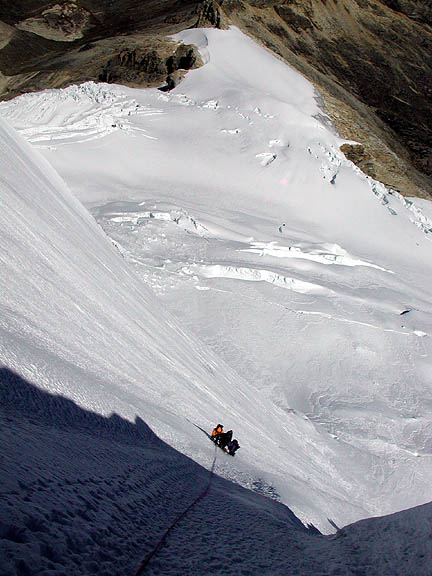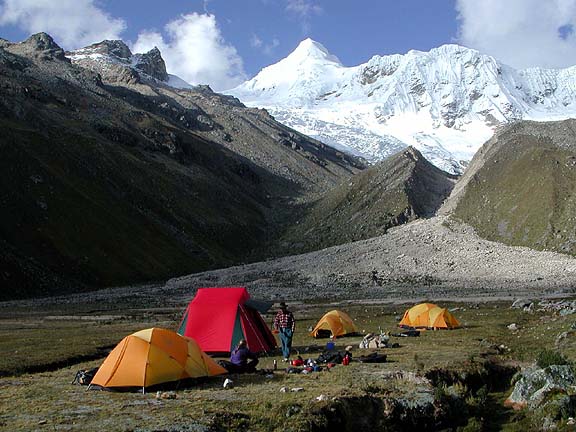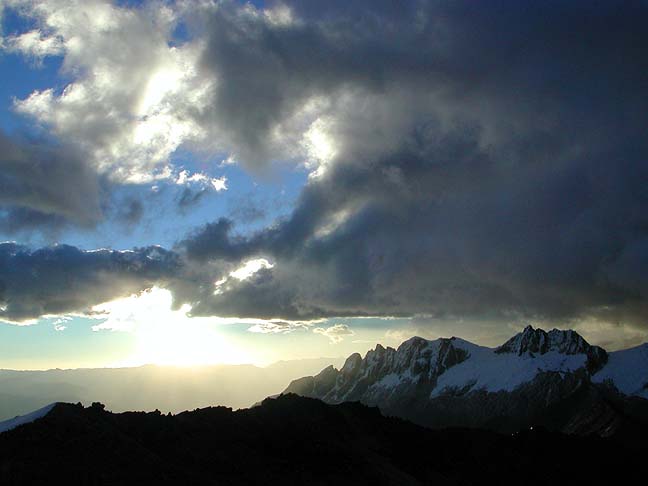
 |
|
| Ishinca Mountaineering Program |  |
| Difficulty Dates Maximum
Ratio See
also:
|
The mountains of the Cordillera Blanca are considered by most climbers to be the most spectacular high summits of the Andes. A brief look at nearly any guide book which covers the high peaks of South America will show you that nearly all the mot challenging ascents are located here. The peaks are so pointed and ice-clad, that it can be difficult to find an area where attractive summits are accessible to mountaineers who are anything less than expert climbers. The Ishinca, fortunately, is one such area. Quebrada Ishinca is a large valley surrounded by spectacular summits. There is big vertical relief here. The upper valley floor, which is wide relatively flat and comforting with its grasslands and stands of Quenual trees, is about 14,000 feet. The surrounding peaks tower to heights of over 20,000 feet for the larger ones, with a greater number in the 18 to 19,000 foot range. There are a great variety of summits from which to chose. Because of the general rugged and highly glaciated nature of the Cordillera Blanca, all climbs offer spectacular views and the ambiance is unforgettable. Because of the great variety of the climbs surrounding the Ishinca Valley, the area is suitable for climbers of all abilities. For those climbers with less experience, this is also a good choice for training and preparation for taking skills to higher summits. Depending on the group we include various amount of additional instruction, including belay skills, more advance ice climbing techniques and instruction on high altitude physiology. It is our belief, however, that the best teacher for climbing is simply to climb, and we will spend as much time as we can on making actual ascents. |
|
You may have noticed that our maximum ratio of climber to guide is only 2:1. We feel this better allows us to address you personal needs and also to make ascents of the most challenging climbs of which you are comfortable capable. We wan to maximize your potential, both for learning as well as for enjoying great climbs. The lower ratio is significantly different from many other guide services who offer similar trips, whether they be in Peru, Bolivia or Ecuador. In choosing a trip you should give careful consideration to the maximum climber to guide ratio as this, more than any other single factor determines what you will be able to accomplish. Difficulty There is a great deal of latitude in how difficult this trip might be. With such a low ratio we can do a good job of tailoring the the trip to an individual's ambitions and energy levels. It remains, however, a trip at high altitude and because of this a high level of fitness is required. All of the summits in the area require cramponing and considerable rock scrambling, most of it easy, but on rough ground. The approach trails to both Urus and Tocllaraju are very rough and steep. The altitude gain from base camp to even the lowest summits is at least 3000 feet, again emphasizing the need for good fitness. Program Prerequisites Climbers need to be in excellent physical condition, and tough! Previous off-trail scrambling experience is required. Technical climbing experience is helpful, but not required, so long as you are quite strong. Previous high altitude experience is recommended, but not required. If you hope to do the harder climbs, such as the West Face of Tocllaraju, then you'll need considerable previous experience in technical ice. |
||||
 |
|
| Camp on the col between Nevado Ishinca and Ranrapalca. | |
 |
|
| Climbing on the West Face of Tocllaraju. | |
|
Ishinca
Mountaineering Program Itinerary |
|||||
| Day -1 | Fly to Lima. Most climbers take a late night flight out of Miami, arriving in Lima very early in the morning the next day. | ||||
| Day 0 |
Arrive early AM in Lima. We recommend you plan on spending this day in Lima. This gives you an opportunity to rest, explore a bit of the city and deal with delayed baggage if necessary. |
||||
| Day 1 |
Van to Huaraz. We'll have a private van for our journey to Huaraz. The trip to Huaraz takes most of the day. We usually arrive just in time to see the setting sun on the peaks at the southern end of the Blanca. On arrival we check into our hotel, the Hostal Andino, generally agreed to be the finest hotel in Huaraz. (Hostal Andino, Pedro Cochachin #357, phone 721-662, fax 722-830) |
||||
| Day 2 |
Laguna Churup day hike. In order to begin our acclimatization and to give ourselves a bit of a rest from traveling we take a short day hike to Laguna Churup. This azure colored glacial fed lake nestled under 18,017 foot Nevado Churup, is not far from Huaraz. At about 14,600' in elevation, Laguna Churup is an excellent destination to help us begin the process of adapting our bodies to the demands of high altitude climbing. Return to Hostal Andino for the night. |
||||
| Day 3 |
Leaving Huaraz early we drive a short way north, downstream in the Callejon de Huaylas, the large valley that borders the Cordillera Blanca on its west side. Soon we turn east and climb up to the town of Collón. From here, we load our equipment on burros and begin the easy trek into Base Camp. The trek normally takes only about 4 hours. This is a lovely walk, passing through dense forests of Quenual trees before emerging into the upper broad valley where we will establish our base camp at about 14,000 feet. This will be our home for the next 2 weeks, and other than the high camps we may elect to place during our ascents around the valley we will get to enjoy the relative comfort of of a well equipped cooking tent and Emilio's superb cooking talents. |
||||
| Day 4 |
Our first order of business is to become better acclimated to the higher altitudes of they area. We normally begin our stay with an easy walk, exploring the valley. |
||||
|
Days 5-14 |
Once our bodies have become more adapted to the elevation we take on more ambitious goals. First we address instructional needs of the program, climbing up to the glacier's edge, where we practice cramponing skills, use of the ice axe and cover rope belaying, and a variety of protective strategies for alpine climbing. We will adjust our itinerary depending on the goals and previous experience of our group. Once we have covered needed climbing skills, we begin our program of ascents. There are a large number of climbs in the area, all of varying difficulty. We expect to make about three different ascents. There are a number of options, but most commonly these may include: Ishinca, a 18,138 foot peak, and perhaps technically the most straightforward in the valley. It is still a big climb, however, involving glacier travel and a significant elevation gain above our base camp. We may chose to place a high camp, both to break up an otherwise long day but also to further acclimate to the high elevations. Urus, 17,778 feet, is another great peak, involving somewhat steeper climbing, especially on the summit structure. Tocllaraju, a large summit at the head of the valley. This is the most demanding of the three climbs mentioned here and required a high camp before reaching its 19,785 foot high summit. On Tocllaraju we will put all of our skills to the test, climbing steeping belayed pitches on the upper part of the climb. There are also much more difficult routes and peaks in the area. These include the West face of Tocllaraju, comparable to Alpamayo, but without the crowds; Vallunaraju, which can be climbed via its fine North Ridge with a high camp just north of the Yangyaraju's. And there are new routes to be done on the Urus peaks, including a spectacular one we tried in 2004 but were turned back just shy of the summit for lack of pitons. We would love to go back! |
||||
| Day 15 |
We make an early morning departure on our hike out. Again, with our heavy gear on burros we are able to enjoy the trek back to carrying only day packs. Normally we arrive out at the road in early afternoon. After purchasing a bottle or two of pop, or beer if your inclined, we load up our waiting van and head back out to Huaraz. After a hot shower, its down into town for a celebratory dinner. |
||||
| Day 16 |
We return to Lima via our van, departing Huaraz in the mid-morning. Usually we have time to enjoy a good final meal together and have plenty of time to get to the airport for the late evening departures for the States. |
||||
| Day 17 |
Flights leaving Lima near midnight get into Miami at about 5 in the morning, giving everyone plenty of time to make connections for their flights home. |
||||
 |
|
| Ishinca Base Camp with Tocllaraju behind. | |
 |
|
| The Urus peaks at sunset. | |
 |
Kathy Cosley & Mark Houston AMGA Certified • SNGM members All images, layout and text ©2004 Cosley & Houston Alpine Guides, All Rights Reserved |
|